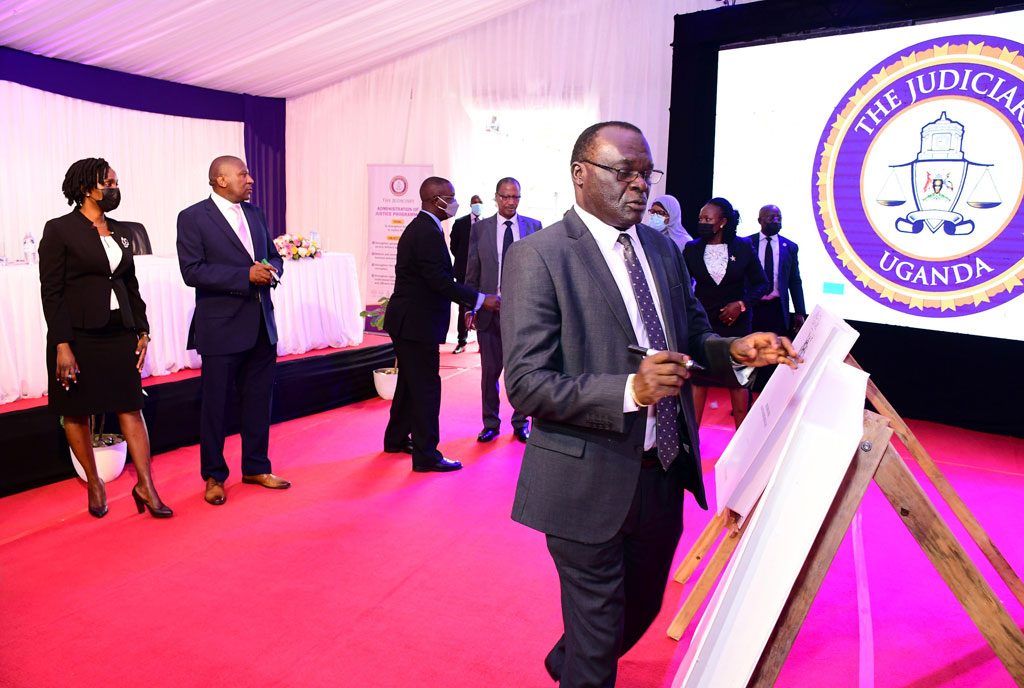Prime
How Judiciary Council reduced case backlog

Chief Justice Alfonse Owiny-Dollo signs on a dummy copy of the Constitution (Bail Guidelines for Courts of Judicature), Practice Directions, 2022, during its launch at High Court in Kampala on July 27. PHOTO/FILE
What you need to know:
- The council, which was inaugurated in March last year, has seen an increase in the number of judicial officials.
When the Administration of the Judiciary Act, 2020 came into force two years ago, the creation of the Judiciary Council was part of it.
The council includes the Deputy Chief Justice, Attorney General, Principal Judge, Chief Inspector of Courts, a judge representing the superior courts, the chairperson of the Uganda Law Council, among other judicial officials.
Following its inauguration in March last year, the council, which sits on a quarterly basis, has since been able to advise Chief Justice Alphonse Owiny-Dollo on several projects.
These include increase in the number of justices of the Supreme Court from 10 to 20, the Court of Appeal from 14 to 55, and the High Court judges from 82 to 150.
Also expanded was the number of chief magistrates from 100 to 160 and grade one magistrates from 386 to 514.
The Chief Registrar, Ms Sarah Langa, told Daily Monitor at the weekend that the move will ensure that there are regional Courts of Appeal, more High Court Circuits, a chief magistrate in every district and a grade one magistrate in every constituency.
“The Judiciary is progressively filling these vacancies with High Court now having 72 judges. For the first time, the Judiciary has 77 chief magistrates and 301 grade one magistrates,” Ms Langa said.
She added that the Judiciary’s coverage has improved with the operationalisation of six high court circuits in Hoima, Rukungiri, Iganga, Tororo, Luweero and Moroto districts.
A total of 16 chief magistrates courts in Isingiro, Sironko, Mayuge, Kiryandongo, Dokolo, Oyam, Bubulo, Lugazi, Kyenjojo, Kamwenge, Pader, Katakwi, Rakai, Kumi, Kira, and Kotido are also functional.
Ms Langa said prior to these recruitments, the Judiciary had only 42 chief magistrates most of whom were circuiting between two and five magisterial areas.
For example, in 2020, the chief magistrate of Fort Portal was care taking Kyenjojo, Bundibujo, Ntoroko, Kamwenge and Kasese magisterial areas.
Ms Langa also said grade one magistrate courts of Kyotera, Kyanika, Kole, Lamwo, Kyazanga, Kangulumira, Namungalwe, Kibito and Nyarushanje were also operationalised.
“The increased deployment registered a significant reduction of case backlog in the grade one magistrate level from 5,085 in November 2021 to 2, 687 at the close of June this year,”Ms Langa said.
Inspectorate of courts
The Judiciary Council has also approved the regulations on committees and the inspectorate of courts. The aim of the courts is to promote good governance in the Judiciary, maintain standards of integrity among the staff, ensure compliance with constitutional and statutory standards on the administration of justice, and promote compliance with the judicial code of conduct.
According to the Chief Registrar, Ms Sarah Langa, the Judiciary also plans to decentralise the inspectorate of courts this financial year. “We await the recruitment of more judicial officers, especially in the ranks of deputy and assistant registrars to be deployed as inspectors. We want to tackle the vice of absenteeism and unethical conduct by ensuring the presence of Inspectors across the courts in the country,” she said.




